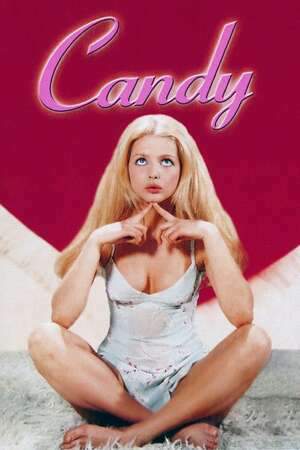Warning: spoilers below!
Haven’t seen Candy yet? This summary contains major spoilers. Bookmark the page, watch the movie, and come back for the full breakdown. If you're ready, scroll on and relive the story!
Candy (1968) – Full Plot Summary & Ending Explained
Read the complete plot breakdown of Candy (1968), including all key story events, major twists, and the ending explained in detail. Discover what really happened—and what it all means.
Candy, Ewa Aulin wakes from a daydream during her father T.M. Christian’s social sciences class, a moment that hints at the film’s surreal baroque style. After a poetry recital at Candy’s school, the enigmatic Welsh poet MacPhisto, Richard Burton, offers her a ride home in his limousine. What begins as a casual lift quickly turns uncomfortable as MacPhisto becomes inebriated and overreaches, forcing himself on her before the moment spirals into confusion and danger.
With the help of her Mexican gardener, Emmanuel, Ringo Starr, Candy is brought inside to help MacPhisto out of his liquor-soaked clothes. Inside, MacPhisto recites poetry in a basement setting while he hums a mannequin’s arousal into a troubling scene, and Emmanuel reacts with alarm, underscoring the film’s relentless intrusion of unsettling sexuality into everyday life. The disturbing turn unsettles Candy and propels a drastic family decision: her father, T.M. Christian, decides she should move away, sending her to New York to live with his twin brother Jack and Jack’s wife Livia.
At the airport, Emmanuel’s three sisters confront Candy, accusing her of corrupting their brother, a moment that erupts into chaos and leads to a head injury for T.M. The Christians escape by boarding a military plane commanded by General Smight, a formidable presence who embodies the movie’s militaristic and surreal interference with Candy’s life. In a grim bargain, General Smight demands that Candy undress in exchange for a blood transfusion for T.M.—a chilling moment that culminates in him accidentally triggering the plane’s paratroopers to leap, only for him to tumble out of his parachute harness in a symbolic fall from grace.
The flight deposits Candy in New York, where Dr. Krankheit (Dr. A.B. Krankheit) begins a clinical, public surgery on T.M. in front of an audience, while Uncle Jack attempts to seduce Candy during a post-operative cocktail party. The hospital’s executive director, Dr. Arnold Dunlap, John Huston, rebukes Candy for what he deems Lewd behavior, sending her into a fainting spell that heightens the film’s sense of social control turning coercive. Dr. Krankheit then lures Candy into a trap by pretending to conduct a medical examination, and the doctor’s disturbing cavalcade grows darker as he brands the nurses with his initials and eyes Candy as the next target for capture. Candy escapes, but the chase continues through streets that feel almost mythic in their mood of panic and pursuit.
Candy’s wandering takes her to a Sicilian bar in Greenwich Village, where an offbeat underground filmmaker, Jonathan J. John, Enrico Maria Salerno, records her for a provocative film. The scene swells into a light riot as a police sergeant and Officer Charlie arrive and beat the filmmaker, and Candy emerges drenched and wary, moving from one hazard to the next. In Central Park, a hulking, hidden figure—the hunchback, played by Charles Aznavour—takes Candy to a deserted mansion for the night. Thieves intrude, the house is ransacked, and the hunchback rapes Candy atop a grand piano, a traumatic episode that intensifies the sense of vulnerability that threads through the night-time wanderings. The police’s rough frisking plan escalates into a chaotic crash into a club full of drag queens, turning pursuit into a carnival of mayhem, and Candy escapes again.
The next leg of Candy’s voyage leads her to a back-of-truck road trip with Grindl, a sham guru played by Marlon Brando Marlon Brando, who teaches her the “seven stages of enlightenment” as a pretext for sex. After days on the road, Grindl suggests another guru will guide her further, a frontier marked by shifting symbols and landscapes rather than a straightforward journey. The trip lands them in California, where Candy keeps ahead of a pursing chase from the New York police, proving resourceful in outwitting the authorities as the road unfurls into a dream-state odyssey.
In a pivotal turn, Candy discovers a robed figure with a toucan on his shoulder, his face covered with white clay. She follows him into an underground Hindu temple that partially collapses, and as the two proceed to have sex, the figure’s face is finally washed clean to reveal that he is, in fact, her brain-damaged father T.M. The revelation ties the day’s disorienting adventures back to a single, haunting truth about Candy’s lineage and the fragility of identity.
As Candy wanders across a sunlit field, banners flutter and hippies play music, and a parade of familiar faces from her journey reappears in a final, kaleidoscopic reel, she seems to accept and reinterpret the episodes she has lived through. In the film’s closing image, Candy returns to outer space, echoing the opening premise and suggesting that the entire odyssey may be less a linear plot than a vast, cosmic reverie about innocence, power, desire, and the boundaries of reality.
Last Updated: October 09, 2025 at 09:30
Unlock the Full Story of Candy
Don't stop at just watching — explore Candy in full detail. From the complete plot summary and scene-by-scene timeline to character breakdowns, thematic analysis, and a deep dive into the ending — every page helps you truly understand what Candy is all about. Plus, discover what's next after the movie.
Candy Timeline
Track the full timeline of Candy with every major event arranged chronologically. Perfect for decoding non-linear storytelling, flashbacks, or parallel narratives with a clear scene-by-scene breakdown.




